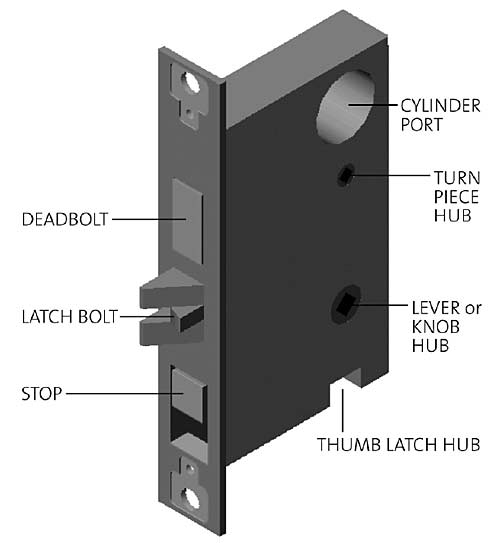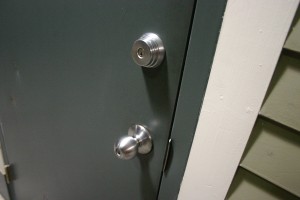We partner with a plethora of industries ranging from restaurant and retail to pharmacies and medical facilities, and our customers’ knowledge of door and lock hardware varies as much as their industry focus’. Not everyone is understands the different types of locks and their applications, and when we are performing a specification analysis with our customers we often hear “Well, what’s the difference?” As a general rule – there’s a HUGE difference. See for yourself:
Mortise Lock
 A mortise lock is one that requires a pocket—the mortise—to be cut into the door where the lock is to be fitted and is common in commercial construction.
A mortise lock is one that requires a pocket—the mortise—to be cut into the door where the lock is to be fitted and is common in commercial construction.
- The parts included in the typical mortise lock installation are:
- The lock body (the part installed inside the mortise cut-out in the door)
- The lock trim (which may be selected from any number of designs of levers, handlesets and pulls)
- A strike plate, which reinforces the holes placed in the frame for the latch or deadbolt to extend into
- The keyed cylinder which operates the locking/unlocking function of the lock body
Cylindrical Lock
A cylindrical lock is designed to be installed through the door with a knob or lever on either side that retract the latch when turned or depressed.
The main advantage of a cylindrical lock is its relatively quick installation. Two holes are drilled in the door, one through the face of the door for the lock chassis and the other through the strike edge of the door for the latchbolt. Cylindrical locksets require less time for installation since a mortise pocket doesn’t need to be drilled and chiseled out. Cylindrical locksets are commonly found in homes, offices, and interior doors. Check out this post to see the internal mechanisms of a cylindrical lock.
Are there any hardware “what’s the difference?” mysteries you’d like solved? Leave a comment in the section below and we’ll lay it all on the line.
Google


You don’t need expensive tools or lots of experience to install or replace a cylindrical lockset because most cylindrical locksets require a standard sized 2 and 1/8 inch door hole. Perpendicular to that hole another smaller cross bore hole is drilled through the door edge to accommodate the latch bolt. Most doors come pre-drilled, ready for hardware. That convenience is in keeping with the need for simplicity that led to the invention of cylindrical locksets at the beginning of the 20th century. Up to that time, mortise locks were used, but mortise locks are more complex, requiring more complicated manufacturing, installation and maintenance than cylindrical locksets.
Working of cylindrical locks
Mr. Wallace – you may have already taken your test, if not here are some of your answers.
1. Cylindrical lock – the cylinder for the key is in the knob or lever of the door
5. To determine if a single door is Left Hand, Right Hand, Left Hand Reverse, or Right hand reverse, stand on the outside (Keyside) of the door. If the hinges are on the left and the door opens inward (Away from you) it is a left hand door. If the hinges are on the left and the door swings to you it is a Left Hand Reverse. Right Hand Door – Hinges are on the right and door swings away from you. Right Hand Reverse – hinges are on the right and the door swings toward you.
1. What type lock is it when key enters through door knob? a) cylinder b) mortise c)Dead bolt d) other
2. What hinge affords the widest opening? a) Butt b) Offset pivot c) Center pivot d)other
3.What is typical swinging grocery store door hinge? a) butt b) offset pivot c) center pivot d) other
4.Sliding glass door channel is made of a)steel b)marble c)iron/copper d) pvc/rubber
5. Standing on the exterior of a bldg how to you note if a door is: LH, RH, LHR, RHR?
These are exact questions on a test I am taking June 02. Any help is much appreciated.
I am in need of very specific answers to the test questions I submitted
The main thing to know about mortise locks is that they use the same mechanism as cylinder locks, just encased inside a box.
The main advantage to having the mechanism encased is to ensure it’s integrity. Cylinder locks work as long as it’s installed squared and perpendicular to the operator. If it’s not installed straight, there can be tear and wear on the mechanism over time, which will lead to failure.
The main disadvantage is the prep work that goes into your door. In North America, it’s common for homes to be fitted for cylinders. It’s the most economical lock. Thus, it’s a industry standard to prep the doors for the cylinder. Unless market pressure change from cylinder to mortise, you will have to eat up the cost to have your door prep to fit the mechanism.
If your a home owner and still deciding if you should go for a mortise or cylinder, the most important thing to ask is who is going to install the lock and look at the price tag for installation first.
I have a client that wants to change from cylindrical locket with deadbolt to a mortise lock and i am wondering if that is possible?
Without seeing a picture I cant say 100%, but more than likely you shouldn’t have any major issues provided you use a wrap plate prepped (including the edge) from the factory. Again, depending on your particular door, you may be better off with two remodel plates prepped for the mortise lock you want to install.